Encountering a ‘DNS server not responding’ error can be frustrating for users since it prevents them from accessing your WordPress site.
This common issue can be due to several factors, such as network problems or incorrect DNS settings.
With years of experience troubleshooting various WordPress errors, we have gained firsthand knowledge of the most common issues and the easiest, most effective ways to fix them.
In this article, we will show you how to easily troubleshoot and fix the ‘DNS server not responding’ error in WordPress.
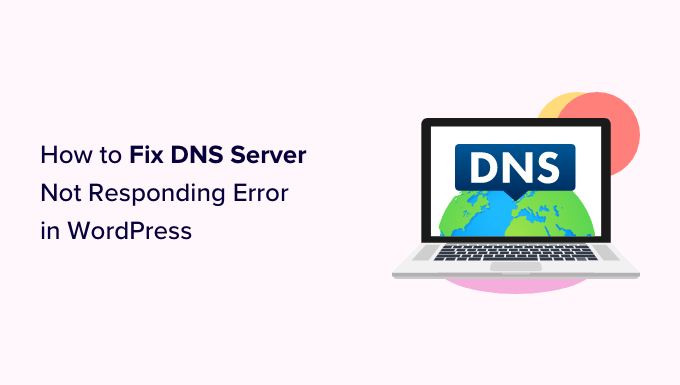
What Is the ‘DNS Server Not Responding’ Error in WordPress?
The ‘DNS server not responding’ error is one of the most common WordPress errors that users can come across.
This error prevents you from visiting your website, which makes it difficult to troubleshoot. Many beginners aren’t sure if it is just them or everyone else seeing this error.

The ‘DNS server not responding’ error means that your browser was unable to establish a connection with the website’s hosting servers.
This error usually occurs when a DNS provider is unavailable, there are firewall issues, network connectivity problems, or there is an issue with your internet modem or router.
That being said, let’s take a look at multiple ways to easily troubleshoot and fix the ‘DNS server not responding’ error on your website:
1. Check Your Internet Connection
You may get the ‘DNS server not responding’ error because your internet connection has been disconnected. So, to start, you need to make sure that you are currently connected to the internet.
If your Wi-Fi is connected, but the error is still present, then you can restart your internet connection by switching your computer on and off.
Or, you can simply disconnect your router from its power supply and then wait at least a minute before reconnecting it.
After that, try visiting your WordPress blog to see if the error has gone.
2. Try Switching to Another Web Browser or Incognito Mode
Sometimes, this error occurs because there is an issue in your default web browser.
You can try to solve the ‘DNS server not responding’ error by visiting your WordPress site using a different browser, such as Mozilla Firefox or Microsoft Edge.
For example, if you use Google Chrome and the browser is showing the ‘DNS server not responding’ error, then try accessing your website using Mozilla Firefox.
You could also try opening the page in a private tab, such as using Chrome’s Incognito mode. If you can access the website in the other browser, that means the problem is with your default web browser.
In that case, you can clear the browser cache to see if that fixes the issue. If that doesn’t solve the problem, then you can try reinstalling the browser.
3. Disable Your Firewall or Antivirus
Firewall and antivirus programs protect your computer from malicious software.
However, sometimes, these programs can also block trustworthy sites due to strict settings or an issue within the program itself.
To check if you are getting the ‘DNS server not responding’ error due to this software, you need to temporarily deactivate your firewall and antivirus programs.
If you are using Windows, then you can easily disable firewall and antivirus programs by selecting the ‘Settings’ app from the Start menu.
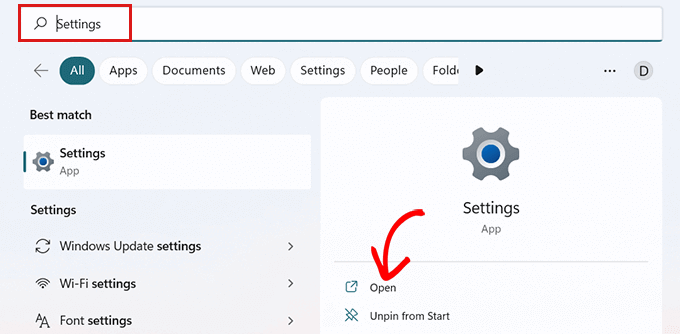
Once it opens up, click the ‘Privacy and Security’ option from the sidebar.
From here, choose the ‘Windows Security’ option.

This will direct you to a new screen where you must select the ‘Virus and Threat Protection’ option from the list.
After that, toggle the switch under the ‘Microsoft Defender Firewall’ option and set it to Off.
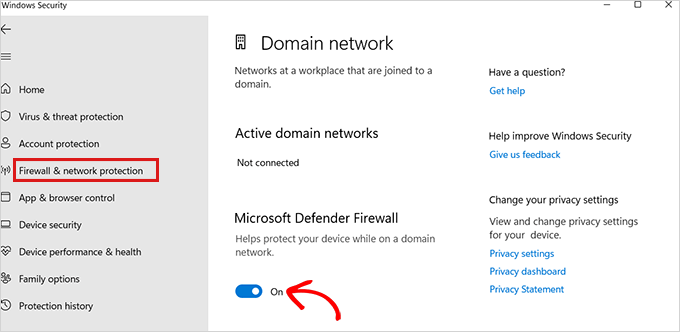
If you are using a Mac, then simply go to System Preferences » Security and Privacy from the Apple toolbar.
This will take you to the ‘Security and Privacy’ window.

Here, simply click the ‘Firewall’ tab and then turn off the firewall.
You have now disabled the antivirus and firewall programs on your computer.
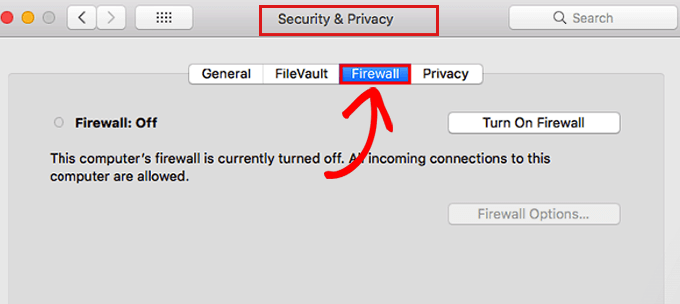
After disabling the firewall, visit your webpage to see if the error has been resolved.
4. Change the DNS Server Address
Sometimes, the ‘DNS server not responding’ error happens when the DNS server assigned to you by your internet service provider is unavailable or has incorrect information.
In that case, you can solve the problem by switching to a different public DNS server, such as Cloudflare or Google Public DNS, which offers DNS addresses for free.
If you use Windows, go to the Windows Search Box from the taskbar and type ‘ncpa.cpl‘ to access the Network Connections page.
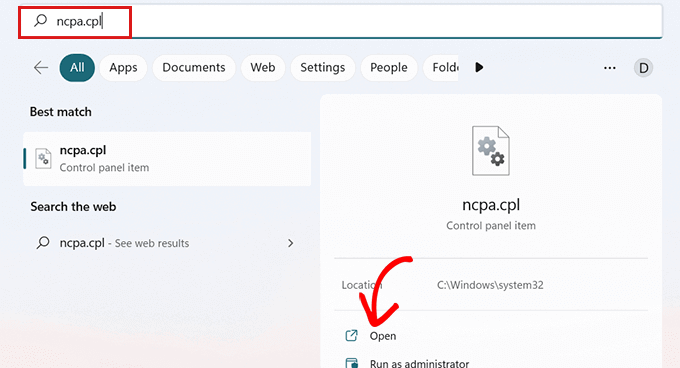
Once you are there, right-click on the internet connection that you’re currently using.
Next, simply select the ‘Properties’ option from the prompt that opens up.
At this point, you may need to provide an administrator password. If you don’t have those permissions, contact your IT department or computer admin.
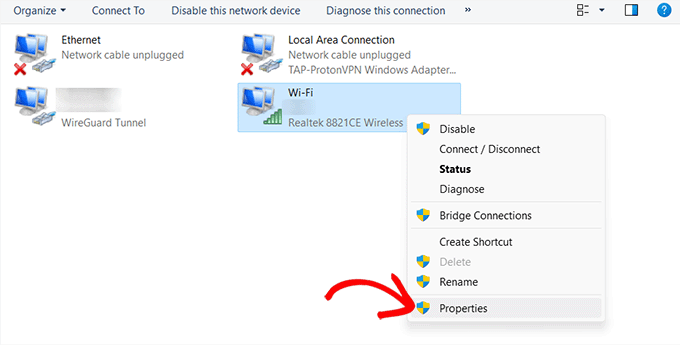
After that, you will see the ‘Properties’ window.
Here, you have to locate and double-click the ‘Internet Protocol Version 4 (TCP/IPv4)’ option from the list, which will open up a new window.
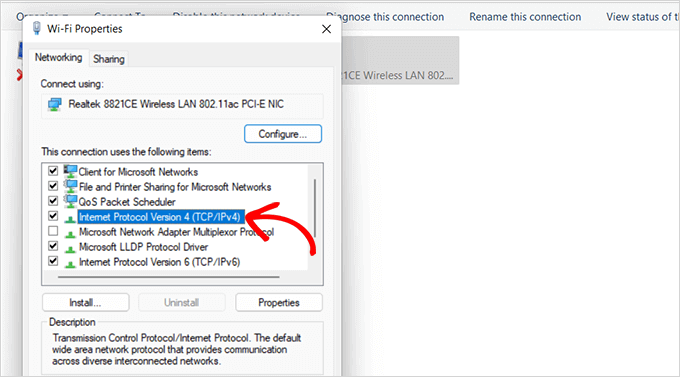
Once here, simply check the ‘Obtain an IP address automatically’ box and then check the ‘Use the following DNS server addresses’ box.
After that, you need to type the DNS address you obtained from the public DNS servers and click the ‘OK’ button at the bottom.
For example, Cloudflare’s public DNS is 1.1.1.1, and Google’s public DNS is 8.8.8.8 and 8.8.4.4.
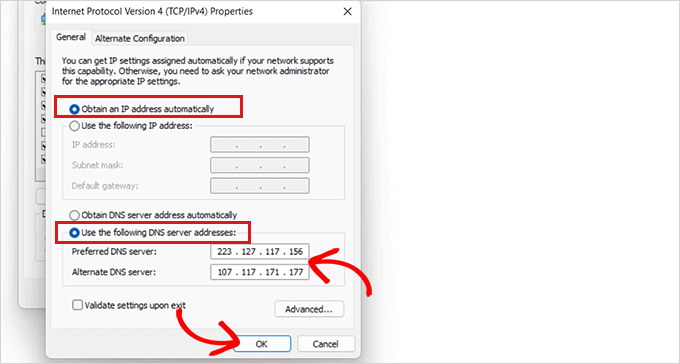
Now restart your computer and visit your site to see if the error is resolved.
If you are a Mac user, simply select the Apple icon in the toolbar and click the ‘System Preferences option.

In the popup that appears, select ‘Network’ and then click on the ‘Advanced’ button.
After that, simply open the ‘DNS’ tab. Here, you will find a ‘+’ button in the bottom-left corner.
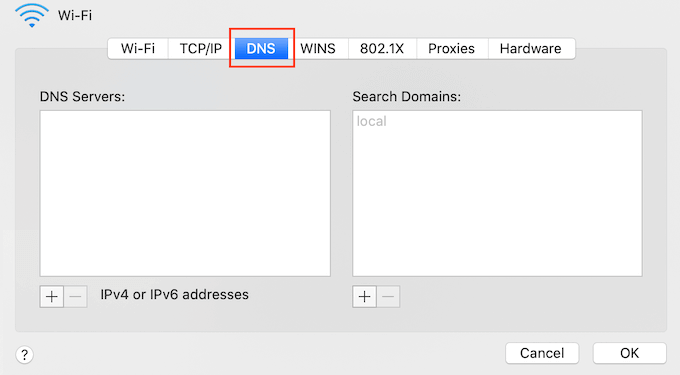
Clicking it will add a new DNS server with the address 0.0.0.0.
Now, go ahead and type the numbers for the preferred DNS server you want to use.
For example, Cloudflare’s public DNS is 1.1.1.1, and Google’s public DNS is 8.8.8.8 and 8.8.4.4.
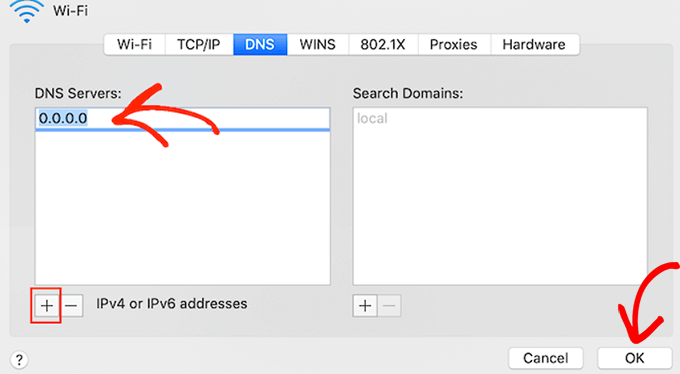
After that, simply click on the ‘OK’ button, which will take you back to the previous popup.
Here, click the ‘Apply’ button to save your changes.

Now, you need to visit your site to check if the error has been removed.
5. Flush Your DNS Cache
Just like your browser, the computer also stores all the IP addresses of the websites that you visit, so it won’t have to look up the same IP address twice.
However, DNS cache information can get outdated, which can cause the ‘DNS server not responding’ error on your site.
This can happen when you move your site to a new domain name or to a new WordPress host.
Flushing your DNS cache can remove the ‘DNS server not responding’ error. For more instructions, check out our guide on how to clear your DNS cache on Mac, Windows, and Google Chrome.
Bonus: Use WPBeginner Pro Services For Site Maintenance
Once you have fixed the ‘DNS server not responding’ error, it is important to update and maintain your WordPress site regularly. This will help prevent malware and malicious code, improving user experience.
If you don’t have the time to manage your own website, then we recommend using WPBeginner Pro Services, which offers the best website maintenance service for WordPress.

We offer amazing maintenance packages at affordable prices that include uptime monitoring, cloud backups, theme and plugin updates, emergency support, and more.
We’ll monitor your site 24/7 and make regular updates as required. You will also be connected with a dedicated account manager who can assist you with any errors and issues on your site.
You can also hire experts at WPBeginner Pro Services for tasks like hacked site repair, custom website design and development, and site speed optimization.
We hope this article helped you learn how to easily fix the ‘DNS server not responding error’ in WordPress. You may also want to check out our guide on what to do when you are locked out of WordPress admin or our tutorial on how to fix excessive DOM size in WordPress.
If you liked this article, then please subscribe to our YouTube Channel for WordPress video tutorials. You can also find us on Twitter and Facebook.





Jiří Vaněk
I had problems after migrating the website to a different server. I couldn’t figure out why everything worked on another PC but not on the machine where I did the migration. Since it was a Windows computer, I tried clearing the DNS cache, and that solved the problem. Now I know that even such a trivial issue can cause a significant headache. It was just an old IP address in the cache.